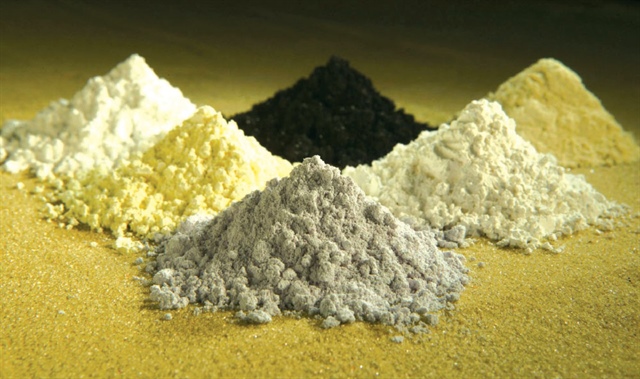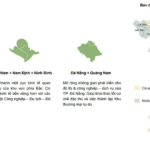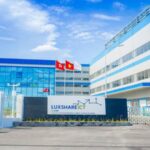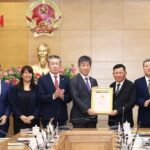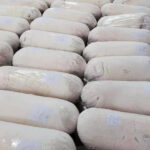
Attracting investment to develop a modern mineral industry requires consideration through appropriate policies. Image: TL |
Vietnam’s mineral industry remains largely focused on mining, crude processing, and exporting low-grade minerals. The number of businesses engaged in deep processing, possessing advanced technology, and refining ore to an international standard is limited. Therefore, developing Vietnam’s mineral industry towards deep processing, mastering modern technology, minimizing environmental pollution, and attracting investment is a consistent orientation across many periods. Most recently, Resolution No. 10-NQ/TW dated February 10, 2022, of the Politburo on the orientation of the strategy for geology, minerals, and mining industry development by 2030, with a vision towards 2045, has set the task of attracting investment projects using advanced and modern technology in mineral exploitation and processing.
The direction for the development of Vietnam’s mineral industry, including the synchronous, effective, and sustainable development of the mining, processing, and utilization industries for rare earth minerals, was also emphasized in Resolution No. 68-NQ/TW dated May 4, 2025, of the Politburo on private economic development (Resolution No. 68-NQ/TW) and Decision No. 866/QD-TTg of the Prime Minister on the approval of the master plan for exploration, exploitation, processing, and use of minerals for the period of 2021-2030, with a vision towards 2050.
With a starting point of certain limitations in science and technology in the mineral industry, attracting investment to develop a modern mineral industry requires consideration through appropriate policies. Among them, the financial obligations to the state budget are an aspect that needs attention.
“License Fee” and “Resource Tax” in the Mineral Industry
In Vietnam, there are currently two parallel concepts: “license fee” and “resource tax.” The “license fee” refers to the amount that organizations and individuals must pay to be granted the right to exploit natural resources. The “resource tax” is understood as an indirect tax levied directly on the output of exploited resources.
The current legal basis for taxation in Vietnam considers these two financial obligations to be distinct and non-overlapping. The “license fee” is determined as a one-time or periodic payment that an organization or individual must make to obtain the right to use state-owned natural resources. The “resource tax” is an official tax levied on the value of exploited resources, regardless of whether the right to exploit them has been granted or not.
However, in practice, both types of levies are related to mineral exploitation activities, leading to businesses bearing two separate financial obligations: the license fee for permission to exploit a certain volume of minerals and the resource tax on the actual volume of exploited minerals.
The mineral resource tax policy in Vietnam reveals some aspects that need to be reassessed legally and practically. Issues such as output conversion, tax rates, license fees, and guidelines on taxable price can pose challenges for businesses and affect the development of the strategic mining industry.
For example, a company exploiting limestone pays a license fee of VND 500 million to be permitted to exploit a mine for five years, with an output of 10,000 tons. The same company then pays resource tax based on the actual volume of exploited limestone (e.g., 10,000 tons x VND 50,000/ton x 10% tax rate = VND 50 million/year). These two levies are applied to the same exploitation activity but at different stages (before and after exploitation).
Very few countries worldwide have regulations on license fees for mineral exploitation based on the permitted mineral reserves, which must be paid before obtaining the exploitation license. Similar regulations, if any, are usually based on actual output and revenue, similar to resource taxes and applied instead of resource taxes. In other words, the license fee would not exist simultaneously with the resource tax. During the drafting of the Law on Geology and Minerals, the Ministry of Natural Resources and Environment (now the Ministry of Agriculture and Environment) once suggested reconsidering the regulation on license fees, but it did not receive agreement from the Ministry of Finance due to budgetary considerations.
Financial Obligations for Mineral Exploiting Enterprises
Currently, a mineral-exploiting enterprise has to pay various taxes, fees, and charges, including:
First, taxes: resource tax, export tax, corporate income tax, and value-added tax.
Second, fees and charges: fees for the exploitation and use of geological and mineral data; fees for mineral exploration (refunded to the state); environmental protection fees and environmental protection fees for wastewater for mineral exploitation and processing establishments.
Third, other budgetary contributions: environmental restoration deposit, land rent, mineral exploitation license fee, and water resource exploitation license fee.
Overall, this extensive list of financial obligations has been and continues to affect the competitiveness of mineral enterprises and the attraction of investment.
Specifically, for the resource tax, the provisions of Vietnamese law are relatively high compared to other countries. Most countries now collect resource taxes as a percentage of revenue, ranging from 2.5% to 7.5% of revenue. For example, China levies a 6.5% resource tax on tungsten, Australia levies around 2.5% on copper depending on the state, and Indonesia has a maximum rate of 10%. South Africa collects between 0.5% and 7%, or a fixed amount on the volume of raw ore extracted. For instance, India collects about 20 rupees (USD 0.23)/ton of 1% WO3 ore, China applies it to specific mines, or the resource tax is levied as a percentage of profit – for example, 14% in Chile and 22.5% in Australia.
Thus, the average resource tax rate globally ranges from 3% to 8% of revenue, with the lower rate (3%) typically applied to minerals extracted in large quantities (such as construction stones) and the higher rate (8%) applied to high-value minerals (such as gold and diamonds). According to the current calculation method, the rate in Vietnam is much higher than the global average and can vary from 20% to 30% of revenue, depending on the type of mineral.
Method for Calculating Resource Tax
Based on the provisions of Article 2 and Article 5 of the Law on Resource Tax No. 45/2009/QH12; Article 3 and Article 4 of Decree No. 50/2010/ND-CP detailing and guiding the implementation of a number of articles of the Law on Resource Tax (amended and supplemented in Decree No. 12/2015/ND-CP); and Article 5 and Article 6 of Circular No. 152/2015/TT-BTC guiding the resource tax, the resource tax is calculated as follows:
Resource tax payable in the period = Taxable resource output x Taxable unit resource price x Resource tax rate
In this method, two aspects related to “taxable resource output” and “taxable unit resource price” need further clarification:
For taxable resource output: According to Clause 4, Article 4 of Decree No. 12/2015/ND-CP, “If the taxable price of a resource is determined at a certain stage, the taxable output of that resource shall be applied at that stage.” For industrial products (deep-processed products with investment in modern technology and equipment), this rule can be understood to mean that the taxable output is calculated based on the output of industrial products. However, in reality, some state agencies calculate it by converting it back to the output of raw ore extracted without considering factors such as depreciation, errors, recoverability, and investment costs. This can lead to an overestimation of the taxable output, especially for multi-component ores such as poly-metallic ores and rare earth ores.
For the taxable unit resource price: According to Point c2, Clause 5.1, Article 6 of Circular No. 152/2015/TT-BTC and Point b, Clause 2, Article 9 of Circular No. 44/2017/TT-BTC, the taxable price of industrial products = Selling price of industrial products – Processing cost of industrial products decided by the provincial People’s Committee. However, up to now, most provinces have not issued the taxable price for industrial products but have used the price of raw ore for calculation. Moreover, the taxable price of some industrial products is currently higher than the price of refined ore. This causes losses for mineral exploitation and processing enterprises.
In the field of rare earths, a new field with concentrated processing technology in a few countries, rare earth ore is a strategic multi-component ore (up to 17 components). After processing, rare earth ore yields products such as rare earth oxides (REOs), rare earth metals (REMs), or rare earth compounds (REC). The current method of taxation will increase tax obligations, affecting the attraction of investment in this field.
Proposed Solutions
The current resource tax policy, with its characteristics of tax rates and output calculation methods, can have significant financial implications for businesses, especially in the field of exploiting and deeply processing strategic minerals. This can affect international competitiveness and investment attraction, as well as the goal of private economic development in line with Resolution No. 68-NQ/TW.
The imposition of tax on the entire volume of raw ore, including the unrecoverable portion, does not encourage deep processing – a crucial strategy for enhancing added value. Compared to countries like China, Chile, Indonesia, and Australia, which offer tax incentives for deep-processing enterprises, Vietnam’s policies need to be reviewed to create investment incentives for advanced technology.
To address these issues, when considering adjustments to tax laws, Vietnam can consider reforming resource tax regulations towards international practices as follows:
First, reconsider the license fee for mineral exploitation. It is possible to study the elimination of the separate license fee or the incorporation of this fee into the resource tax to avoid overlapping in taxable objects.
Second, apply taxation based on actual value. Consider collecting resource tax as a percentage of revenue (between 3% and 8%) or a fixed profit, instead of converting it to a single metal ore. This would be consistent with the spirit of Clause 4, Article 4 of Decree No. 12/2015/ND-CP and Article 6 of Circular No. 152/2015/TT-BTC, which emphasize the taxable value based on industrial products.
Third, encourage deep processing. Apply tax incentives to enterprises investing in deep processing technology to increase added value and competitiveness.
Fourth, improve the overall legal framework. It is necessary to update regulations such as Circular No. 44/2017/TT-BTC and Decree No. 67/2019/ND-CP to ensure consistency and practicality, in line with the spirit of Resolution No. 66-NQ/TW on renewing legislation work to meet the requirements of national development in the new era.
The mineral resource tax policy in Vietnam, although designed to manage natural resources, reveals some aspects that need to be reassessed legally and practically. Issues such as output conversion, tax rates, license fees, and guidelines on taxable prices can pose challenges for businesses and affect the development of the strategic mining industry. Reforming the policy towards transparency, fairness, and international practices is necessary to promote the mining industry, support the private sector, and enhance national competitiveness, in line with the spirit of innovation in Resolution No. 66-NQ/TW and Resolution No. 68-NQ/TW.
Dr. Vu Kim Hanh Dung – Atty. Tran Quoc Dat
– 16:00 30/06/2025
“Unleashing the Potential: Bolstering Investment Appeal for the Real Estate Sector”
The new policy is a strategic shift that elevates Vietnam’s position in the global value chain, enhancing its investment competitiveness and marking a significant leap forward.
The Top Tier: Unveiling the Fortunate Few in Vietnam’s Real Estate Sector.
“The merger of provinces, as assessed by Vietcombank Securities (VCBS), will result in improved land funds and developmental spaces for major cities and large-scale industrial projects. This strategic move is expected to create favorable conditions by offering expanded opportunities for urban expansion and industrial growth.”
The Rise of Central Vietnam: From Underdog to Tech Giant Hub
With Foxconn, Luxshare, and Goertek’s Arrival, the Region Invests in Ports, Airports, and Energy Infrastructure to Support its Soaring Ambitions.
Once considered a backwater region for investment, this central province has now emerged as one of the top 10 destinations for FDI in the country.

